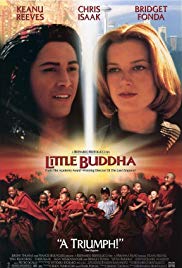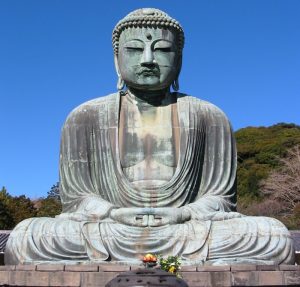LITTLE BUDDHA
SUBJECTS — Religions/Buddhism; World/Tibet;
SOCIAL-EMOTIONAL LEARNING — None.
MORAL-ETHICAL EMPHASIS — Citizenship.
AGE: 10+; MPAA Rating — PG (brief glimpse of male nudity);
Drama; 1996; 120 minutes; Color.
There is NO AI content on this website. All content on TeachWithMovies.org has been written by human beings.

SUBJECTS — Religions/Buddhism; World/Tibet;
SOCIAL-EMOTIONAL LEARNING — None.
MORAL-ETHICAL EMPHASIS — Citizenship.
AGE: 10+; MPAA Rating — PG (brief glimpse of male nudity);
Drama; 1996; 120 minutes; Color.
TWM offers the following worksheets to keep students’ minds on the movie and direct them to the lessons that can be learned from the film.
Film Study Worksheet for a Work of Historical Fiction and
Worksheet for Cinematic and Theatrical Elements and Their Effects.
Teachers can modify the movie worksheets to fit the needs of each class. See also TWM’s Historical Fiction in Film Cross-Curricular Homework Project.
Buddhist monks suspect that a child born in Seattle is the reincarnation of their spiritual master. They go to the child’s family and convince the father to take the boy to Tibet to determine if he is, in fact, the reincarnation. They introduce the child to the life story of the Buddha, which is re-enacted in the film. The film was inspired by the experiences of Sonam Wangdu (born 1992) who was the child of a Buddhist family from the U.S. and the great, great nephew of a revered leader of a sect of Tibetan Buddhism.
Selected Awards:
None.
Featured Actors:
Keanu Reaves, Bridget Fonda, Chris Isaac, Ruocheng Ying, Alex Weisendanger.
Director:
Bernardo Bertolucci.
“Little Buddha” will expose children to the story of Siddartha, who became the Buddha by choosing to seek Enlightenment. The film was panned by some critics as unworthy of feature status, because it was in essence a Buddhist Sunday School class. This is exactly how we propose to use the film, i.e., to teach children the story of the Buddha. This Learning Guide attempts to give a brief description of the fundamentals of Buddhism.
MINOR. The child’s family from the U.S. is shown as being devoid of any religion or belief system of their own.
Discuss with your child as many of the concepts in the Helpful Background section as you can.

Buddha said that he was a teacher/therapist who recognized the cause of life’s pain and despair and then proposed the cure: changing our perspective on life and the world by recognizing that pain and despair was separate from the self. When this realization is complete, a person becomes enlightened and attains a state in which the boundary of the finite self is extinguished. An enlightened person becomes one with all things, a condition beyond the limitations of body and of mind; beyond thought, feelings and will.
Buddha did not claim to be divine. He was not a savior, but rather a teacher and therapist. Buddhists do not worship the Buddha, instead, they revere him. Enlightenment is not a mystical encounter with God. Rather it is an exercise in becoming more fully human by directly realizing the nature of reality.
Buddha, the Enlightened One, was born in Lumbini, Nepal in the sixth century B.C.E. He was the son of the leader of a minor kingdom but early on showed interest in reflection and meditation. It is difficult to separate the reality of his life from the myth, but it is clear that he left marriage and an indulgent life for meditation and the search for Enlightenment. He rejected the Hindu caste system as well as Hindu asceticism. In about the year 528 B.C.E. Buddha experienced the Great Enlightenment. A short time thereafter, he preaching his first sermon revealing the way of salvation from suffering, the gist of Buddhism. Buddha continued to teach, gathering disciples around him for 45 years until he died from eating spoiled food at the age of 80.
Buddha’s teachings have influenced the lives of millions of people for more than 2,500 years. He established a religion that is one of the primary religions of the world. He rejected metaphysical speculation. He required that religious thinking be logical, a concept previously absent from Oriental religious thought. His revolt against the extremes of Hindu hedonism, asceticism, and spiritualism, and his rejection of the caste system deeply influenced Hinduism itself.
Buddhism is based upon a recognition of the “Four Noble Truths:”
(1) life is imperfect and leads to suffering (examples: birth, illness, aging, death, being tied to what one abhors, being separated from what one loves); in other words, life is not permanent;
(2) the will to individual personal fulfillment is the cause of life’s imperfection and suffering, i.e., a man, no matter how charitable, will be more concerned with his children getting enough to eat than with others getting enough to eat;
(3) the cure to life’s imperfection/impermanence/suffering is to overcome the will to individual personal fulfillment; and
(4) the EIGHT FOLD PATH is the way to overcome the will to individual personal fulfillment.
Buddha approached religion as a therapy to cure the inevitable tragedy of life rather than an effort to ascertain cosmological truth.
THE EIGHT FOLD PATH is a rigorous course of training designed to form habits that release the individual from impulse, ignorance of self and the will to individual personal fulfillment. To embark on the Path a person must first associate himself with those who have experience following the Path, preferably a teacher who has found Enlightenment and a group of people seeking to attain Enlightenment. The eight steps are:
1. RIGHT KNOWLEDGE (belief in the Four Noble Truths);
2. RIGHT ASPIRATION (intense determination to transcend separateness and identify with the welfare of all);
3. RIGHT SPEECH (an examination of speech to determine the motives that lead to statements that are untrue and to ensure that statements are accurate and clear);
4. RIGHT ACTION (an examination of behavior and deeds to determine motives so that we only act with selflessness and charity; this leads at a minimum to the Five Precepts: (i) do not kill (strict Buddhists extend this to animals and are therefore vegetarians); (ii) do not steal; (iii) do not lie; (iv) do not be unchaste; (v) do not drink intoxicants; these are only the beginning, and an observant Buddhist must act with selflessness and charity in all other matters as well;
5. RIGHT LIVELIHOOD (certain occupations are helpful in acting rightly and others make it almost impossible; the modern emphasis is that earning a living is a means to obtaining the necessities of life and not an end in itself);
6. RIGHT EFFORT (it takes tremendous effort to curb the will to individual personal fulfillment, reign in passions and eliminate evil states of mind);
7. RIGHT MINDFULNESS (continuous alertness and self-examination; the greatness of man is based upon his self-awareness);
8. RIGHT CONCENTRATION (an understanding that our true self is vastly more wonderful than we now realize and a passion for direct experience of its full reach).
The Eight Fold Path is not easy and traditionally it has been followed in a monastery into which the adherent goes for refuge. Tibetan Buddhism has a “refuge prayer:”
I go for refuge in the Buddha, the enlightened teacher; I commit myself to enlightenment;
I go for refuge in the Dharma, the spiritual teachings; I commit myself to the truth as it is;
I go for refuge in the Sangha, the spiritual community; I commit myself to living the enlightened life.
This film was partially inspired by the story of Sonam Wangdu (born 1992), the child of a Buddhist family from the U.S. and the great, great nephew of Deshun Rinposte III, a revered Lama of the Sakya sect of Tibetan Buddhism. Today the two centers of the sect are in Seattle and Nepal. Deshun Rinposte rebuilt an important temple in exile in Katmandu. He predicted that he would be reborn in Seattle. Sonam Wangdu’s mother had dreams while she was pregnant that her son would be a great teacher. A leader of the Sakya sect also dreamed that Sonam Wangdu was the reincarnation of Deshun Rinposte. Sonam Wangdu is now living in a monastery in Katmandu and is studying to become the leader of his sect. It is reported by those that believe in the reincarnation, that at the child’s birth a golden light filled the delivery room, that the child was unusually compassionate with others, and that when taken to the room of Deshun Rinposte the child identified the Master’s chair.
1. See Discussion Questions for Use With any Film that is a Work of Fiction.
2. What are the Four Noble Truths?
Suggested Response:
See the Helpful Background Section.
3. What is the Eight Fold Path?
Suggested Response:
See the Helpful Background Section.
4. What was Buddha’s approach to religion?
Suggested Response:
Buddha approached religion as a therapy to cure the inevitable tragedy of life rather than an effort to ascertain cosmological truth.
5. Did Buddha tell people what to believe about God?
Suggested Response:
No. Buddha wasn’t concerned with metaphysics.
6. Did Buddha teach that he was a divine being?
Suggested Response:
No. Buddha held himself out as an ordinary man who was a teacher.
7. Buddhism arose out of Hinduism. What religions in the West have grown out of other religions?
Suggested Response:
Christianity grew out of Judaism. Islam also grew from Judaism.
8. Buddha was a great teacher and moral leader and the founder of a religion. Name some other men who also founded new religions.
Suggested Response:
Jesus Christ, Muhammad.
9. Can you see any parallels in the lives of Buddha and Jesus?
Suggested Response:
They were both great teachers. Their teachings gave rise to great religions adhered to by millions of people. They both passed tests which were very similar (power on earth, bodily pleasures, etc.).
10. Give another name for the term “the will to separate personal fulfillment.”
Suggested Response:
The ego.
11. Watch how the use of color in this movie plays on our subconscious emotions. What colors are used in the scenes in the U.S.? What colors are used in the scenes in Tibet? What message is the director trying to send?
Suggested Response:
The colors in Seattle are blue and cool and the colors in Tibet and in the story of Siddartha are warm colors: yellows, reds, oranges, and browns. The concept is that Tibet and the story of Siddartha are where the subject of the film can flourish while the U.S. is a sterile environment.
Discussion Questions Relating to Ethical Issues will facilitate the use of this film to teach ethical principles and critical viewing. Additional questions are set out below.
(Do your share to make your school and community better; Cooperate; Stay informed; vote; Be a good neighbor; Obey laws and rules; Respect authority; Protect the environment)
1. Buddha gave up his life of luxury to find enlightenment, but once he had attained that state, he did not rest. What did he do and how does it relate to the Citizenship pillar of ethical conduct?
Suggested Response:
Buddha became a teacher and sought to share with others his discovery of a cure for pain and despair. He worked hard to benefit society.
There is no one formulation of the Four Noble Truths or of the Eight Fold Path. A few versions are set out below;
In addition to websites which may be linked in the Guide and selected film reviews listed on the Movie Review Query Engine, the following resources were consulted in the preparation of this Learning Guide:
This Learning Guide was last updated on January 17, 2012.